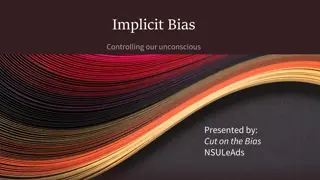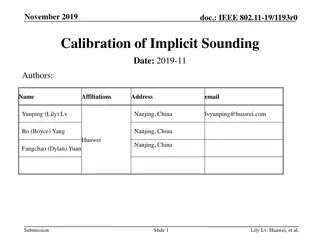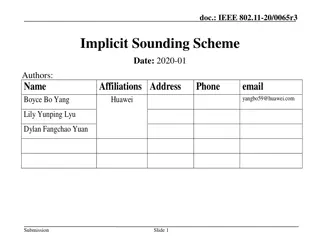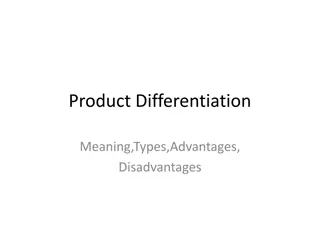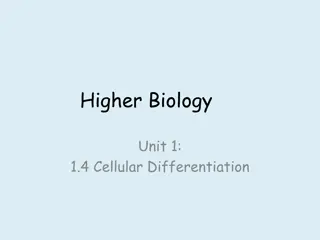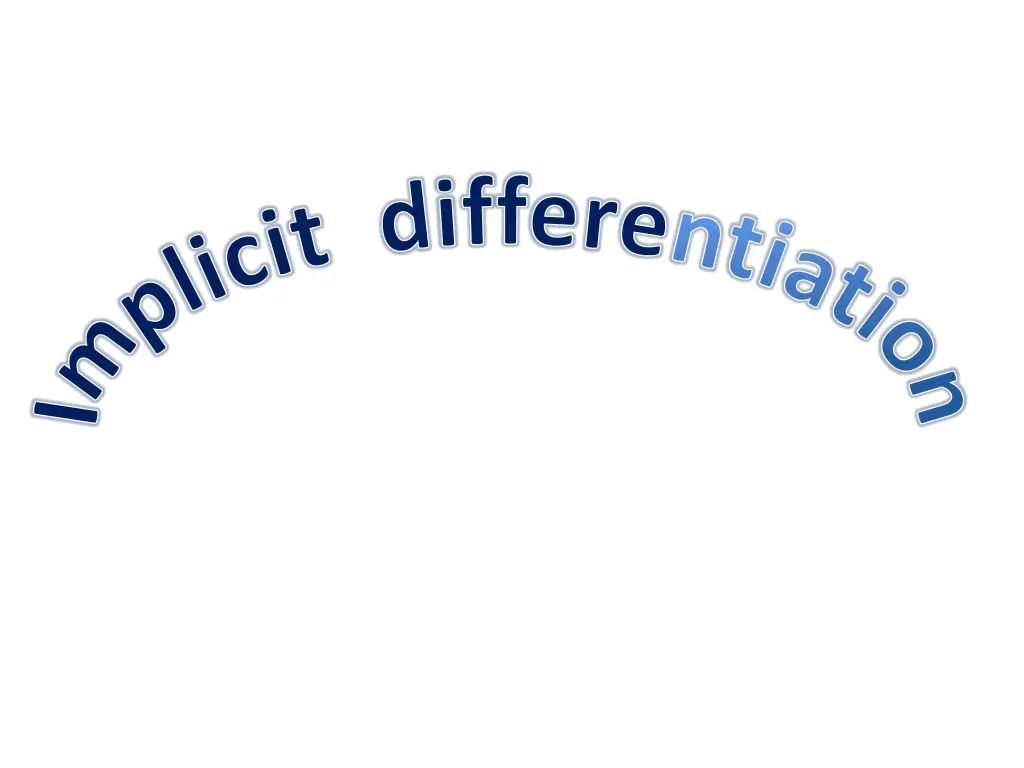
Understanding Implicit Differentiation: Examples and Techniques
Explore the concept of implicit differentiation, including its application to single terms and functions with mixed x and y terms. Learn key examples and techniques to find gradient functions effectively.
Download Presentation

Please find below an Image/Link to download the presentation.
The content on the website is provided AS IS for your information and personal use only. It may not be sold, licensed, or shared on other websites without obtaining consent from the author. If you encounter any issues during the download, it is possible that the publisher has removed the file from their server.
You are allowed to download the files provided on this website for personal or commercial use, subject to the condition that they are used lawfully. All files are the property of their respective owners.
The content on the website is provided AS IS for your information and personal use only. It may not be sold, licensed, or shared on other websites without obtaining consent from the author.
E N D
Presentation Transcript
Differentiation: Implicit KUS objectives BAT Understand Implicit differentiation and find the gradient function for functions in x and y Starter differentiate: ?3?+ ?2 2 ?3+ 32 6?2(?3+ 3) 2 ?3?+ ?2 (3?3? + 2?) ?sin? ?2?2?2 54 2?2?2?2 54+ 8? ?2?2?2 53 sin? + ? cos? ?3 4?(1 + 3?2) tan? 3 ?2tan? ?3sec2? tan2? !!!!
Notes Implicit differentiation of single terms For some equations it is impossible to rearrange to give y = f(x) and hence differentiate. One approach is to use the chain rule to differentiate each term without rearrangement For example differentiate y2 ? ?2 ?? ?? ? ??(?2) = ??= 2? ?? ?? ?? ?? ? Differentiate the y term as you would for an x term And multiply by ?? More examples: 8?? ?? ?? 8? 6??? 3?2 ??
WB30a One approach is to use the chain rule to differentiate each term without rearrangement. Here are some Key examples: ? ?? ??= ??? 1?? ?? Term Gradient function Term Gradient function ?4 2? + 5?4.?? ?2+ ?5 4?3 .?? ?? ?? 1 ? 1 ?3 ?2 .?? ?? ?? cos? .?? 1 3? 4 .?? ?? ?? 1 2 3? 1 ?????2?.?? 3 .?? ? 3?2 2 ? ?? sin? cot? ?? ?? 1 6? 3 1 2? 4 .?? ?? .?? ?? 1 ? .?? ?? 1 7(? + 1) 8 .?? ? + 17 ?? ?? ?? 6? 6? .?? ? 6? ?? ?2 3 .?? 2? ln ?2 3 ln? ??
Notes Implicit differentiation of functions Now we can differentiate an entire function with mixed terms in x and y And attempt to rearrange the result to find a gradient function For example the equation of this circle 2? + 2??? ?2+ ?2= 3? + 7 ??= 3 By differentiating each term implicitly Then rearranging ?? ??=3 2? We get a gradient function in terms of x and y 2?
? ?? ??= ??? 1?? WB31 Differentiate the given functions ?? function Gradient function ?2= 6?4 ??=12?3 2??? ??= 24?3 or ?? ? ?2+ ?2+ 6? = 25 ?? ??+ 6 = 0 or ?? ??= (?+3) 2? + 2? ? ??? ? = 4? + 7 ?? ??= 4 or ?? cos? ??= 4sec? ?2= sec? ?? ??= sec? tan? ?? ??= 1 2? ?? 2?sec?tan? ??= ?? 3 ???? ?? ??= ?? ? ??= ?? 2?2??? or ?2?=1 3?3+1 2?2+ 8 ??= ?2+ ? 1 ? + 2 2? ??? = ln(? + 2) ?2 1 ? ?? ??=
The curve C has equation ?3+ ? + ?3+ 3? = 6 a) Find dy/dx in terms of x and y b) Hence find the gradient of C at the point (1, 1) WB32 ?) 3?2+ 1 + 3?2?? ??+ 3?? ??= 0 ?? ?? 3?2+ 3 = 3?2 1 You now have a formula for the gradient, but in terms of x AND y, not just x ?? ??= 3?2 1 3?2+ 3 b) at the point (1, 1) 3(1)2 1 3(1)2+3 ?? ??= = 2 3
Notes Implicit differentiation of functions A special case is the derivative of a product of x and y Key example: differentiate ?(?,?) = ?? using the Product rule ? .?? ? ??(??) = ??? ??+ ? ??+ ?.1 = Key example: differentiate ?(?,?) = ??2using the Product rule ? .2??? ? ??(??^2) = 2???? ??+ ?2 ??+ ?^2.1 =
WB33abc Differentiate the given functions (including products) function Gradient function 2?2+ ?? ? = 2 4? + ? + ??? ?? ??= 0 ?? ?? ??= 4? ? ? 1 ?2+ 2?? + ?2= 7 2? + 2? + 2??? + 2??? ??= 0 ?? ?? ??= 2? 2? 2? + 2? = 1 2? ?3+ 3?2? = 0 2?3+ 2? .3?2?? + 6?? + 3?2 .?? = 0 ?? ?? ?? ??= 2?3 6?? 6?? + 3?2
WB33de Differentiate the given functions (including products) function Gradient function 1.?? ? + ? .1 ?? ?? = 0 ?ln? = 10 ? ?? ??= ?ln? ? ?? ??= 2? .??+ ?2 .???? ? = ?2?? ?? 2? ?? 1 ?2 ?? ?? ??=
WB33fg Differentiate the given functions (including products) function Gradient function ?? ?? 1.sin2? + ?.2cos2? = 0 ?sin2? = 1 ?? ??= sin2? 2? cos2?= 1 2?tan2? 2? .tan? + ?2 .sec2??? ?2tan? = cos? = sin? ?? ?? ??= sin? 2?tan? ?2sec2?
WB34The curve C has equation 4??2 5? = 11 a) Find dy/dx in terms of x and y b) Hence find the gradient of C at the point (1, 2) 4 .?2+ 4? .2??? ?) 5 = 0 ?? ?? ?? 8?? = 5 4 ?2 ?? ??=5 4 ?2 You now have a formula for the gradient, but in terms of x AND y, not just x 8?? b) at the point (1, 2) ?? ??= 11 16
WB35 A circle has equation ?2+ ?2= 25 Find two equations of tangents to the curve when x = 4 differentiating2? + 2??? ?? = 0 rearranges to ?? ?? = ? ? ?2= 25 42 when ? = 4 ? = 3 ?? ?? = 4 At (4, 3) 3 ?? ?? =4 At (4, -3) 3 y 3 = 4 3(? 4) y + 3 =4 3(? 4) Tangent 4? + 3? = 25 Tangent 4? 3? = 25
WB36 Exam Q A curve C is described by the equation 3?2 4?2+ 4? 5? + 12 = 0 Find an equation of the normal to C at point (3, 3), giving your answer in the form ?? + ?? + ? = 0 6? 8??? ??+ 4 5?? M1A1 ??= 0 at the point (3, 3) ?? ?? =6?+4 8?+5=22 M1A1 29 Gradient of normal is ? = 29 A1 22 Equation of normal is ? 3 = 29 22? 3 29? + 22? 153 = 0 M1A1
WB37 Find the value of dy/dx at the point (1,1) where ?2?ln? = ? + ? 2 Give your answer in terms of e 2?2? .ln? + ?2? .1 ?? ?? = 1 +?? ? ?? at the point (1, 1) 2?2 .ln1 + ?2 .1 ?? ?? = 1 +?? 1 ?? Rearranges to dy dx?2 1 = 1 2?2ln1 But ln 1 = 0 so dy dx?2 1 = 1 dy dx = 1 ?2 1
KUS objectives BAT Understand Implicit differentiation and find gradient function for functions in x and y Crucial points Make sure that you understand the process of differentiating an equation implicitly Write one thing you have learned Write one thing you need to improve







